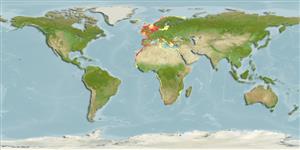>
Syngnathiformes (Pipefishes and seahorses) >
Syngnathidae (Pipefishes and seahorses) > Syngnathinae
Etymology: Syngnathus: Greek, syn, symphysis = grown together + Greek, gnathos = jaw (Ref. 45335).
More on author: Linnaeus.
Environment: milieu / climate zone / depth range / distribution range
Ecologia
marinhas; estuarina demersal; não migratória (Ref. 88171); intervalo de profundidade 0 - 110 m (Ref. 4281), usually 3 - 15 m (Ref. 126547). Subtropical; 71°N - 35°S, 19°W - 42°E
Eastern Atlantic: Norway, Faroes and British Isles to Western Sahara, Senegambia, and from Namibia to Cape of Good Hope and northward to the coast of Zululand in the western Indian Ocean (Ref. 4127). Also throughout the Mediterranean, Aegean and Black seas. Despite literature records, occurrence in the Indo-Pacific outside South African waters lacks conclusive evidence (Ref. 4281).
Comprimento de primeira maturação / Tamanho / Peso / Idade
Maturity: Lm 16.3, range 7 - 25.6 cm
Max length : 50.0 cm TL macho/indeterminado; (Ref. 35388)
Espinhos dorsais (total) : 0; Raios dorsais (total) : 33 - 42; Espinhos anais: 0; Raios anais : 3. Light greenish to dark brown in color with variable markings (Ref. 4281). Snout cylindrical, equal to or less than eye diameter. With 18 - 19 body rings between head and dorsal fin (Ref. 35388). The snake pipefish (Entelurus aequoreus) is distinguished by the lack of pectoral and anal fins (Ref. 88171). An elongated bump on top of head behind eye (Ref. 59043).
Found in coastal and estuarine waters to depths of at least 110 m (Ref. 4281); on sand, mud and rough bottoms. Common amongst algae and eel-grass (Zostera) (Refs. 4146, 6733, 88187). Feeds mainly on small crustaceans (Ref. 85544). It is parasitised by the monogenean Gyrodactylus eyipayipi on the body surface, inside the flute and male brood pouch (Ref. 124059).
Ovoviviparous; reproducing on average 3 times each year (Ref. 89328). Several females depositing partial clutches to a male’s brood pouch under the tail (Refs. 205, 31201). Up to 400 eggs may be found in a single pouch (Ref. 89329). Brooding males occur mainly between May and July (Refs. 31201, 58137). During the breeding season, both males and females were observed to remain low amongst the seagrass in one meadow (Ref. 31201). Gestation period lasts about 5 weeks and size at birth is 1.7- 3.5 cm (Refs. 58137, 88187, 89330). Aquarium experiments have shown that new born young are benthic, remaining close to the bottom Ref. 89330).
Dawson, C.E., 1986. Syngnathidae. p. 628-639. In P.J.P. Whitehead, M.-L. Bauchot, J.-C. Hureau, J. Nielsen and E. Tortonese (eds.) Fishes of the North-eastern Atlantic and the Mediterranean. Volume 2. Unesco, Paris. (Ref. 6733)
Status na Lista Vermelha da UICN (Ref. 130435)
Ameaça para os humanos
Harmless
Uso pelos humanos
Pescarias: sem interesse; Aquário: Espécies comerciais
Ferramentas
Relatórios especiais
Baixar XML
Fontes da internet
Estimates based on models
Preferred temperature (Ref.
123201): 10.3 - 22.6, mean 17.7 °C (based on 934 cells).
Índice de diversidade filogenética (Ref.
82804): PD
50 = 0.5000 [Uniqueness, from 0.5 = low to 2.0 = high].
Bayesian length-weight: a=0.00025 (0.00019 - 0.00032), b=3.21 (3.16 - 3.26), in cm total length, based on LWR estimates for this species (Ref.
93245).
Nível Trófico (Ref.
69278): 3.3 ±0.2 se; based on diet studies.
Resiliência (Ref.
120179): médio(a), tempo mínimo de duplicação da população 1,4 - 4,4 anos (Fec=200).
Fishing Vulnerability (Ref.
59153): Moderate vulnerability (40 of 100).
Nutrients (Ref.
124155): Calcium = 54.6 [12.4, 151.7] mg/100g; Iron = 1.02 [0.39, 3.52] mg/100g; Protein = 3.7 [0.1, 7.5] %; Omega3 = 0.286 [0.130, 0.629] g/100g; Selenium = 22.8 [5.1, 60.3] μg/100g; VitaminA = 9.35 [4.02, 21.44] μg/100g; Zinc = 0.838 [0.431, 1.605] mg/100g (wet weight);
